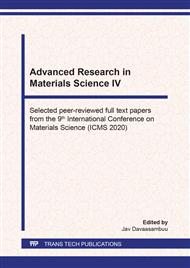p.1
p.8
p.14
p.21
p.28
p.42
p.48
p.56
The Latest Research in Mongolia on the Utilization of Coal Combustion By-Products
Abstract:
With a geological reserve of over 170 billion tons, coal is the most abundant energy source in Mongolia with six operating thermal power stations. Moreover, in Ulaanbaatar city over 210000 families live in the Ger district and use over 800000 tons of coal as a fuel. The three thermal power plants in Ulaanbaatar burn about 5 million tons of coal, resulting in more than 500000 tons of coal combustion by-products per year. Globally, the ashes produced by thermal power plants, boilers, and single ovens pose serious environmental problems. The utilization of various types of waste is one of the factors determining the sustainability of cities. Therefore, the processing of wastes for re-use or disposal is a critical topic in waste management and materials research. According to research, the Mongolian capital city's air and soil quality has reached a disastrous level. The main reasons for air pollution in Ulaanbaatar are reported as being coal-fired stoves of the Ger residential district, thermal power stations, small and medium-sized low-pressure furnaces, and motor vehicles. Previously, coal ashes have been used to prepare advanced materials such as glass-ceramics with the hardness of 6.35 GPa, geopolymer concrete with compressive strength of over 30 MPa and zeolite A with a Cr (III) removal capacity of 35.8 mg/g. Here we discuss our latest results on the utilization of fly ash for preparation of a cement stabilized base layer for paved roads, mechanically activated fly ash for use in concrete production, and coal ash from the Ger district for preparation of an adsorbent. An addition of 20% fly ash to 5-8% cement made from a mixture of road base gave a compressive strength of ~ 4MPa, which exceeds the standard. Using coal ashes from Ger district prepared a new type of adsorbent material capable of removing various organic pollutants from tannery water was developed. This ash also showed weak leaching characteristics in water and acidic environment, which opens up an excellent opportunity to utilize.
Info:
Periodical:
Pages:
8-13
Citation:
Online since:
August 2021
Price:
Сopyright:
© 2021 Trans Tech Publications Ltd. All Rights Reserved
Share:
Citation:


